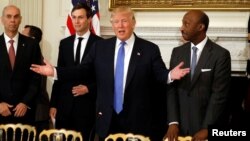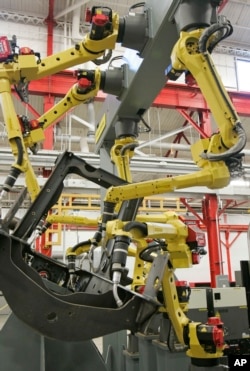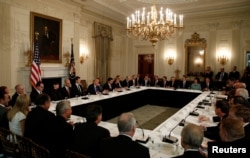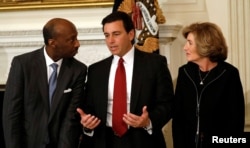President Donald Trump told the heads of more than 20 of the largest U.S. manufacturers Thursday that he planned to bring millions of factory jobs back to the United States.
Trump said the United States had lost one-third of its manufacturing jobs since the North American Free Trade Agreement was signed, and that 70,000 American factories had closed since China joined the World Trade Organization.
Experts say trade and company efforts to take advantage of cheaper labor overseas contributed to the decline of U.S. manufacturing employment, but many economists say the rising tide of automation played a major role in the loss of high-wage factory jobs.
To boost the economy and employment, Trump has said he will change tax policy, cut regulations and spend more money rebuilding roads and other infrastructure, though many details have not yet been announced.
"Everything's going to be based on bringing our jobs back, the good jobs, the real jobs," he said Thursday.
The chief executive officers of General Electric, Lockheed Martin, Dow Chemical and other firms gathered at the White House, where they discussed regulations on minerals extracted in conflict zones, export regulations for military hardware, business taxes and problems finding technically skilled workers for manufacturing jobs.
Focus on creativity
MIT research scientist Andrew McAfee told VOA the U.S. education system was doing a great job of turning out the kinds of workers "we needed 50 years ago." He said schools and employers should put more emphasis on "encouraging creativity" and helping students not just learn to solve problems, but to "figure out what problem we should go chase down next."
He said technology is "lousy at that."
A study by the Deloitte consulting firm says that the U.S. economy will create 3.5 million manufacturing jobs over the next decade, but that more than half of them may go unfilled because companies cannot find people with the right skills. The problem grows from the retirement of millions of baby boomers and the creation of hundreds of thousands of new jobs.
The key to closing this gap is training and retraining for workers, Senator Chris Coons said in a recent Capitol Hill speech. But the Delaware Democrat said the United States had cut its investment in retraining by half over the past 30 years and now spends just one-sixth the amount that other advanced industrial nations put into upgrading workforce skills. He said that hurts economic growth and employment over time.
Republican Senator Thom Tillis of North Carolina told the same gathering the problem was the "mismatch" between workers' current skills and "the needs of the industry."
Other nations' systems
Both lawmakers said Americans should study the system used by Germany, Austria and other nations for apprenticeships, technical training, and updating and upgrading workforce skills. In Germany, companies, schools, unions and government officials work together to figure out what skills are needed for jobs today and in the future, what gaps exist in workers' knowledge, and how to organize appropriate classes and training.
The head of science, technology, engineering and math education at a North Carolina community college said many of his students were already involved in programs that blend academic skills with on-the-job training in a system that borrows ideas from the German model. Chris Paynter said many different kinds of companies are involved, so the program offers a blend of core skills and training customized for the needs of the particular firm that employs the apprentice.
While there has been a lot of concern about manufacturing jobs, Harvard University's James Heskett said the automation and trade that cut jobs from factories could also hurt employment in the far-larger services sector. In a recent blog post, the emeritus professor from Harvard's business school said there might be an even larger job crisis ahead.











